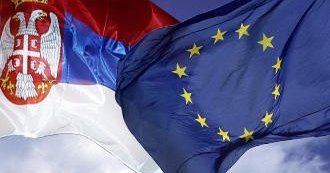Serbs lived through harsh times over the past two decades, having been involved in wars in the 1990s that were followed by a general economic downturn, a sharp decline in living standards, and a rise in unemployment.
As Serbia has commonly been perceived as the aggressor of the wars in former Yugoslavia, the country became stigmatised as the perpetrator and became Europe’s “rogue state” in the 1990s. At the same time, some Serbs see themselves as victims of former Yugoslav president Slobodan Milosevic and his regime as well as the historical circumstances. Memories of the 1999 NATO bombing and economic sanctions evoke bitterness towards the West. The recent past is also a source of tension between the Serbian identity and the image of the West in Serbia.
The history of violence has given the whole Balkan region a pejorative connotation, implying war, violence, and a backwards place in contrast to “civilized” Western Europe. Since the fall of Mr Milosevic in 2000, the country has moved towards Europe, although it is remains a slow and painful process. With president Boris Tadic and a pro-European government in place, many EU leaders hoped that Serbia would overcome the threat of extreme nationalism that could be the potential source of violence.
A nationalist changes his rhetoric
Surprisingly, Tomislav Nikolic of the Serbian Progressive Party (SNS) won the run-off against the incumbent president and pro-Western candidate Boris Tadic on 20 May 2012. In the past, Mr Nikolic was known as an ultra-nationalist and anti-EU politician, having served as a deputy prime minister under Mr Milosevic, who was put on trial for genocide at the tribunal in The Hague. He was in government when NATO bombed Serbia in 1999 and said on record that he would rather see his country ally itself with Russia than join the EU. When Mr Nikolic lost the elections in 2008, his tone changed dramatically as he left the Serbian Radical Party (SRS) and started to embrace the European integration of Serbia into the EU, although he demanded a tougher stance in the negotiations with Brussels.
EU envoy Miroslav Lajcak met the newly elected Serbian president Tomislav Nikolic and made it clear that Brussels would not begin membership talks with Serbia until Belgrade fulfiled its demands on Kosovo. Serbia applied for EU membership in 2009 and was finally granted official candidate status in March 2012. The EU conditions are clear: next to the fulfilment of the Copenhagen criteria, it is necessary to abolish the Serbian parallel institutions in northern Kosovo and implement all agreements between Belgrade and Pristina.
Shortly after his surprise election, Mr Nikolic sparked anger in the region by denying the genocide of 8,000 Bosnian Muslims by Bosnian Serb forces at Srebrenica in July 1995, which is widely known to be the worst massacre on European soil since World War II. He also said the Croatian border town of Vukovar, which was destroyed during an 87-day siege by Serb forces in 1991, “was a Serb town.” His remarks prompted the leaders of most ex-Yugoslav republics as well as Albania to stay away from his inauguration on 11 June 2012.
However, Mr Nikolic seemed to learn quickly that his new post as president entailed a lot of responsibility from his side. As the mistrust against him rose, he announced that Serbia would try to reconcile with Bosnia and Croatia, saying, “I expect the beginning of our cooperation after the end of initial disorientation.” After a meeting with EU foreign policy chief Catherine Ashton during his first visit to Brussels, Mr Nikolic pledged “there is no better future for Serbia than membership in the union.” He promised to reform the political and judicial system in Serbia to speed up the EU bid, as well as the business climate to curb corruption before accession talks could start. At the same, Mr Nikolic made clear that while Serbia would make more efforts to mend ties with Kosovo, it would never recognise Kosovo as a country.
The Kosovo issue remains
Kosovo unilaterally declared its independence from Serbia in February 2008. Mostly populated by ethnic Albanians, Serbia has not accepted Kosovo’s step but rather considers it to be an autonomous province within the country. Serbia should be able to join the EU around 2020, but normal relations with its neighbours are a precondition. Thus, the EU had identified an agreement on regional cooperation as one of the conditions that Serbia would have to meet to become a candidate for EU accession.
The technical dialogue between Belgrade and Pristina since March 2011 is based on the use of strong leverage by Brussels. In the summer and autumn of 2011, tensions in the North flared up, threatening a wider crisis. However, the EU negotiators obtained agreements which should help to normalise the situation, among them the recognition of travel documents, university diplomas, and car license plates.
However, Kosovo and Serbia are still reluctant to genuinely engage each other; positions are primarily addressed to the international community and not between each other. The lack of consideration of the other perspective also makes it so much harder to come to a common stance.
Brussels can exert considerable influence over both sides and is well positioned for a strong mediation role. Also with the new Serbian government, the EU should be able to bring the two sides closer together. Serbia’s strategy to keep its policy on Kosovo separate from its ambitions to join the EU failed, as the EU has made it clear that Serbia’s progress toward accession depends on Belgrade’s improvement of its relations with Kosovo.
Overcoming stereotypes for a common future
The negative image of Serbia harms the country’s development. Joining the EU is often seen as positive for the country’s economic and political stability, despite the current crisis. The majority of Serbs know that the EU improves the opportunities for young people, improved employment possibilities, and freedom to travel freely within Union. Given Serbia’s past, it will be a symbolic step when the country joins the EU, into a stable and peaceful future. This implies that Serbia must overcome the events of its past and position itself as a forward-moving, European nation as the non-governmental and non-profit Serbian Institute for Public Diplomacy (SIPD) promotes in Brussels.
Currently, Serbia lacks initiatives to promote Serbian culture in EU institutions, or with major educational or professional exchange programs. As Croatia will join the Union in 2013, and Serbia remains on its path to the EU, the connotation of the word “Balkan” can be redefined with more positive characteristics. It would also need citizen-to-citizen initiatives based on dialogues and cultural exchange to deal with the violent past and improve the relations with the region as well as EU countries. It will be imperative to present itself as attractive to the EU. However, the country’s future membership will ultimately be linked to finding a compromise over Kosovo. And Mr Nikolic will have to prove his credentials, but he could be the face that truly leads to change.


1. On 22 July 2012 at 05:19, by Milton Replying to: Serbia continues its route towards European integration
Replying to: Serbia continues its route towards European integration
Most of the things said here I can agree with but one thing i don’t understand, how one can call Serbs aggressors when they were trying only to protect their right to live on the land they lived for centuries. Percentage of Serbs in Croatia was some say 33%, some say 18% in 1931. This was greatly reduced to by genocide carried out in WW2 (http://en.wikipedia.org/wiki/World_War_II_persecution_of_Serbs) and further reduced with a help of Western Europe and US in period from 1991 to nowadays to 4%. Can you say these numbers and facts are not true? Of course it is all true, how can you then talk about Serbs being aggressors?
2. On 23 July 2012 at 14:22, by Joe Replying to: Serbia continues its route towards European integration
Replying to: Serbia continues its route towards European integration
Interesting view point from the author, but I think he could’ve touched on further how Serbia should learn that walking forward whilst looking backwards (the past) is only a path to collision. Regarding the comment from Milton “how one can call Serbs aggressors when they were trying only to protect their right to live on the land they lived for centuries”. Maybe Milton should be reminded that it was the Croats that allowed Serbs to settle in their lands when they were escaping the Turkish occupations of Serbia. This is how Serbs want to repay the Croats for allowing their ancestors a safe sanctuary....Let’s just take their land instead. It’s interesting that prior to WW2 there were far more German people intergrated in other European countries for hundreds of years, I wonder if it would’ve been OK for NAzi Germany to use the same argument the Serbs have been using when it comes to “Protecting their right to live on the land they lived for centuries”.....I wonder.
Follow the comments: |
|
